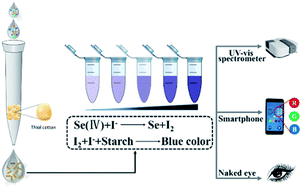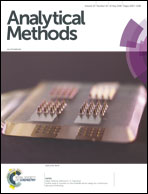Simple multimodal detection of selenium in water and vegetable samples by a catalytic chromogenic method
Abstract
The determination of selenium (Se) has garnered increasing interest because of its importance to life as a nutrient element as well as its toxicological effects. Herein, a simple multimodal colorimetric method was developed for the detection of selenium. Firstly, thiol cotton is used as the functional material for simple solid-phase extraction separation of Se(IV). Then, the enriched Se(IV) oxidizes I− ions into I2 species, leading to the formation of linear triiodide ions that intercalate into the coil of starch molecules, producing a blue color. Based on the changes in the intensity of the blue color, multimodal detection methods using spectrophotometric detection, smartphone app-based colorimetric detection, and naked-eye colorimetric detection were developed for selenium detection. The spectrophotometric detection mode exhibited a linear response from 0.01 to 8.0 μg mL−1 with a detection limit of 0.0047 μg mL−1; the smartphone app-based colorimetric detection mode was linear from 1.0 to 6.0 μg mL−1 with a detection limit of 0.05 μg mL−1; and selenium levels of 0.1 μg mL−1 could be clearly distinguished by the naked eye. The colorimetric detection method was demonstrated to be applicable for the detection of selenium in real water and vegetable samples, giving recoveries of 94.1 to 108.4%.



 Please wait while we load your content...
Please wait while we load your content...